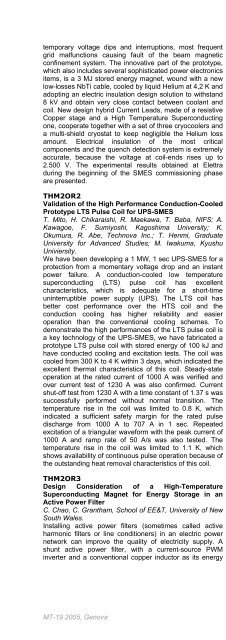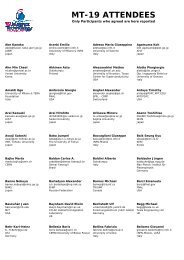Click here to download the abstract booklet in pdf format - MT19 - Infn
Click here to download the abstract booklet in pdf format - MT19 - Infn
Click here to download the abstract booklet in pdf format - MT19 - Infn
Create successful ePaper yourself
Turn your PDF publications into a flip-book with our unique Google optimized e-Paper software.
temporary voltage dips and <strong>in</strong>terruptions, most frequent<br />
grid malfunctions caus<strong>in</strong>g fault of <strong>the</strong> beam magnetic<br />
conf<strong>in</strong>ement system. The <strong>in</strong>novative part of <strong>the</strong> pro<strong>to</strong>type,<br />
which also <strong>in</strong>cludes several sophisticated power electronics<br />
items, is a 3 MJ s<strong>to</strong>red energy magnet, wound with a new<br />
low-losses NbTi cable, cooled by liquid Helium at 4,2 K and<br />
adopt<strong>in</strong>g an electric <strong>in</strong>sulation design solution <strong>to</strong> withstand<br />
8 kV and obta<strong>in</strong> very close contact between coolant and<br />
coil. New design hybrid Current Leads, made of a resistive<br />
Copper stage and a High Temperature Superconduct<strong>in</strong>g<br />
one, cooperate <strong>to</strong>ge<strong>the</strong>r with a set of three cryocoolers and<br />
a multi-shield cryostat <strong>to</strong> keep negligible <strong>the</strong> Helium loss<br />
amount. Electrical <strong>in</strong>sulation of <strong>the</strong> most critical<br />
components and <strong>the</strong> quench detection system is extremely<br />
accurate, because <strong>the</strong> voltage at coil-ends rises up <strong>to</strong><br />
2.500 V. The experimental results obta<strong>in</strong>ed at Elettra<br />
dur<strong>in</strong>g <strong>the</strong> beg<strong>in</strong>n<strong>in</strong>g of <strong>the</strong> SMES commission<strong>in</strong>g phase<br />
are presented.<br />
THM2OR2<br />
Validation of <strong>the</strong> High Performance Conduction-Cooled<br />
Pro<strong>to</strong>type LTS Pulse Coil for UPS-SMES<br />
T. Mi<strong>to</strong>, H. Chikaraishi, R. Maekawa, T. Baba, NIFS; A.<br />
Kawagoe, F. Sumiyoshi, Kagoshima University; K.<br />
Okumura, R. Abe, Technova Inc.; T. Henmi, Graduate<br />
University for Advanced Studies; M. Iwakuma, Kyushu<br />
Univiersity.<br />
We have been develop<strong>in</strong>g a 1 MW, 1 sec UPS-SMES for a<br />
protection from a momentary voltage drop and an <strong>in</strong>stant<br />
power failure. A conduction-cooled low temperature<br />
superconduct<strong>in</strong>g (LTS) pulse coil has excellent<br />
characteristics, which is adequate for a short-time<br />
un<strong>in</strong>terruptible power supply (UPS). The LTS coil has<br />
better cost performance over <strong>the</strong> HTS coil and <strong>the</strong><br />
conduction cool<strong>in</strong>g has higher reliability and easier<br />
operation than <strong>the</strong> conventional cool<strong>in</strong>g schemes. To<br />
demonstrate <strong>the</strong> high performances of <strong>the</strong> LTS pulse coil is<br />
a key technology of <strong>the</strong> UPS-SMES, we have fabricated a<br />
pro<strong>to</strong>type LTS pulse coil with s<strong>to</strong>red energy of 100 kJ and<br />
have conducted cool<strong>in</strong>g and excitation tests. The coil was<br />
cooled from 300 K <strong>to</strong> 4 K with<strong>in</strong> 3 days, which <strong>in</strong>dicated <strong>the</strong><br />
excellent <strong>the</strong>rmal characteristics of this coil. Steady-state<br />
operation at <strong>the</strong> rated current of 1000 A was verified and<br />
over current test of 1230 A was also confirmed. Current<br />
shut-off test from 1230 A with a time constant of 1.37 s was<br />
successfully performed without normal transition. The<br />
temperature rise <strong>in</strong> <strong>the</strong> coil was limited <strong>to</strong> 0.8 K, which<br />
<strong>in</strong>dicated a sufficient safety marg<strong>in</strong> for <strong>the</strong> rated pulse<br />
discharge from 1000 A <strong>to</strong> 707 A <strong>in</strong> 1 sec. Repeated<br />
excitation of a triangular waveform with <strong>the</strong> peak current of<br />
1000 A and ramp rate of 50 A/s was also tested. The<br />
temperature rise <strong>in</strong> <strong>the</strong> coil was limited <strong>to</strong> 1.1 K, which<br />
shows availability of cont<strong>in</strong>uous pulse operation because of<br />
<strong>the</strong> outstand<strong>in</strong>g heat removal characteristics of this coil.<br />
THM2OR3<br />
Design Consideration of a High-Temperature<br />
Superconduct<strong>in</strong>g Magnet for Energy S<strong>to</strong>rage <strong>in</strong> an<br />
Active Power Filter<br />
C. Chao, C. Grantham, School of EE&T, University of New<br />
South Wales.<br />
Install<strong>in</strong>g active power filters (sometimes called active<br />
harmonic filters or l<strong>in</strong>e conditioners) <strong>in</strong> an electric power<br />
network can improve <strong>the</strong> quality of electricity supply. A<br />
shunt active power filter, with a current-source PWM<br />
<strong>in</strong>verter and a conventional copper <strong>in</strong>duc<strong>to</strong>r as its energy<br />
s<strong>to</strong>rage has a significant power loss. The power loss <strong>in</strong> this<br />
copper <strong>in</strong>duc<strong>to</strong>r can be substantially reduced by replac<strong>in</strong>g<br />
<strong>the</strong> <strong>in</strong>duc<strong>to</strong>r with a high-temperature superconduct<strong>in</strong>g<br />
(HTS) magnet. Several solenoid design alternatives us<strong>in</strong>g<br />
silver-shea<strong>the</strong>d BSCCO-2223 tape have been made for <strong>the</strong><br />
HTS magnet that has an <strong>in</strong>ductance of 0.5H for this<br />
application. A liquid-nitrogen-cooled HTS magnet has been<br />
built and tested for use <strong>in</strong> an active power filter. The loss<br />
reduction effect of us<strong>in</strong>g <strong>the</strong> HTS magnet with <strong>the</strong> currentsource<br />
active power filter has been <strong>in</strong>vestigated<br />
experimentally and <strong>the</strong> results are compared with those<br />
when us<strong>in</strong>g a conventional copper <strong>in</strong>duc<strong>to</strong>r. Practical<br />
issues such as air-core design versus iron-core design and<br />
us<strong>in</strong>g liquid-nitrogen cool<strong>in</strong>g or a cryocool<strong>in</strong>g are analysed<br />
and discussed.<br />
THM2OR4<br />
Superconduct<strong>in</strong>g Fault Current Limiter-Magnetic<br />
Energy S<strong>to</strong>rage (SFCL-MES) for Substation<br />
Applications<br />
C. Zhao, L. Xiao, L. L<strong>in</strong>, Y. Yu, Institute of Electrical<br />
Eng<strong>in</strong>eer<strong>in</strong>g, CAS.<br />
In this paper, a new concept of Superconduct<strong>in</strong>g Fault<br />
Current Limiter-Magnetic Energy S<strong>to</strong>rage (SFCL-MES) for<br />
Substation Applications is proposed. By replac<strong>in</strong>g <strong>the</strong> bias<br />
power source of bridge SFCL with <strong>the</strong> current regula<strong>to</strong>r of<br />
SMES, SFCL and SMES are <strong>in</strong>tegrated <strong>in</strong><strong>to</strong> FCL-SMES<br />
with just one superconduct<strong>in</strong>g coil. The pr<strong>in</strong>ciple of FCL-<br />
SMES is analyzed first, <strong>the</strong>n its configuration and operation<br />
mechanism are presented. FCL-SMES can not only limit<br />
<strong>the</strong> peak fault current, but also limit <strong>the</strong> steady fault current<br />
for long time. Moreover, it can provide high-quality power<br />
for <strong>the</strong> critical cus<strong>to</strong>mers of <strong>the</strong> substation at <strong>the</strong> same<br />
time. Its effectiveness is verified by <strong>the</strong> numerical<br />
simulation and experiment.<br />
THM2OR5<br />
Flexible Power Interconnection with SMES<br />
S. Nomura, H. Tsutsui, S. Tsuji-Iio, R. Shimada, Tokyo<br />
Institute of Technology.<br />
Electric power systems are usually <strong>in</strong>terconnected with<br />
each o<strong>the</strong>r through a back-<strong>to</strong>-back direct-current (DC) l<strong>in</strong>k<br />
<strong>to</strong> <strong>in</strong>crease reliability of electric power networks and <strong>to</strong><br />
improve system operations. The objective of this work is <strong>to</strong><br />
discuss <strong>the</strong> concept of a Superconduct<strong>in</strong>g Magnetic Energy<br />
S<strong>to</strong>rage (SMES) system <strong>in</strong>corporated <strong>in</strong><strong>to</strong> a back-<strong>to</strong>-back<br />
<strong>in</strong>terconnection. In this case, <strong>the</strong> back-<strong>to</strong>-back system is<br />
used as a power condition<strong>in</strong>g system for <strong>the</strong> SMES coils.<br />
S<strong>in</strong>ce <strong>the</strong> AC/DC converter can be designed <strong>in</strong>dependently<br />
of <strong>the</strong> frequency of <strong>the</strong> power system, a two-way switch is<br />
connected <strong>to</strong> <strong>the</strong> AC side of each converter. This two-way<br />
switch can select <strong>the</strong> <strong>in</strong>terconnected power system. By<br />
us<strong>in</strong>g <strong>the</strong> two-way switches, this system can <strong>in</strong>crease <strong>the</strong><br />
availability fac<strong>to</strong>r of <strong>the</strong> back-<strong>to</strong>-back system dur<strong>in</strong>g <strong>the</strong><br />
SMES operations and also enables <strong>the</strong> economical power<br />
<strong>in</strong>terchange between <strong>in</strong>terconnected power networks with<br />
an optimal time <strong>in</strong>terval for <strong>the</strong> power demand of each<br />
<strong>in</strong>terconnected power network. This work discusses <strong>the</strong><br />
system configurations and operations of <strong>the</strong> back-<strong>to</strong>-back<br />
<strong>in</strong>terconnection with SMES that enables <strong>the</strong> replacement of<br />
a pumped hydro s<strong>to</strong>rage system. In this case, <strong>the</strong> SMES<br />
system is composed of a number of superconduct<strong>in</strong>g coils<br />
<strong>in</strong> order <strong>to</strong> reduce <strong>the</strong> cost of <strong>the</strong> superconduct<strong>in</strong>g coil by<br />
<strong>the</strong> effect of mass production. In this work, <strong>the</strong> SMES coils<br />
are optimized from <strong>the</strong> required mass of <strong>the</strong> structure and<br />
<strong>the</strong> leakage magnetic field.<br />
MT-19 2005, Genova 120



